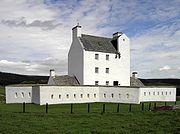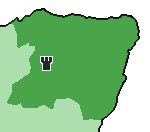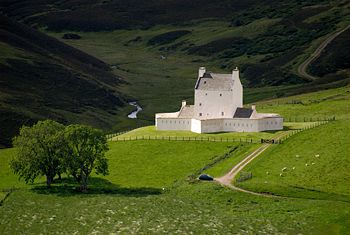
Corgarff Castle
Encyclopedia


Castle
A castle is a type of fortified structure built in Europe and the Middle East during the Middle Ages by European nobility. Scholars debate the scope of the word castle, but usually consider it to be the private fortified residence of a lord or noble...
in Corgarff
Corgarff
Corgarff is a hamlet in Aberdeenshire, Scotland in the Grampian Mountains. The nearby Corgarff Castle was used as a military barracks in the 18th century. The hamlet's primary school closed in 1998.-Footnotes:...
, Aberdeenshire
Aberdeenshire
Aberdeenshire is one of the 32 unitary council areas in Scotland and a lieutenancy area.The present day Aberdeenshire council area does not include the City of Aberdeen, now a separate council area, from which its name derives. Together, the modern council area and the city formed historic...
, Scotland
Scotland
Scotland is a country that is part of the United Kingdom. Occupying the northern third of the island of Great Britain, it shares a border with England to the south and is bounded by the North Sea to the east, the Atlantic Ocean to the north and west, and the North Channel and Irish Sea to the...
.
Through much of its history Corgarff has been of strategic importance, guarding the quickest route from Deeside
Deeside
For Strathdee in Scotland see River Dee, AberdeenshireDeeside is the name given to the predominantly industrial conurbation of towns and villages that lie on, or near the River Dee in Chester. These include, Connah's Quay, Mancot, Pentre, Shotton, Queensferry, Sealand, Broughton, Hawarden,...
to Speyside
Speyside
Speyside can refer to:* Strathspey, Scotland, the famous whisky producing region by the River Spey** Speyside single malts, the type of whisky produced in Strathspey* Speyside, Trinidad and Tobago in Trinidad and Tobago...
, a route later followed by the military road from Blairgowrie
Blairgowrie and Rattray
Blairgowrie and Rattray and Raitear is possibly from an English language cognate of Gaelic ràth, meaning fortress + a Pictish term cognate with Welsh tref, meaning settlement) is a twin burgh in Perth and Kinross, Scotland. Amongst locals, the town is colloquially known simply as "Blair"...
to Fort George
Fort George, Highland
Fort George , is a large 18th century fortress near Ardersier, to the north-east of Inverness in the Highland council area of Scotland. It was built to pacify the Scottish Highlands in the aftermath of the Jacobite rising of 1745, replacing an earlier Fort George built with the same aim after the...
. Its location ensured that Corgarff Castle has had an eventful and sometimes tragic history.
Early history
The castle is thought to have been built in about 1550 by John Forbes of Towie. It would initially have comprised a tower house set within a walled enclosure. The tower house would have been similar to the structure you see today: the surrounding wall would have been very much simpler and probably rectangular in plan.The Forbes family were supporters of the cause of the future James VI
James I of England
James VI and I was King of Scots as James VI from 24 July 1567 and King of England and Ireland as James I from the union of the English and Scottish crowns on 24 March 1603...
in the years following the imprisonment of Mary, Queen of Scots, in England. The Gordon
Clan Gordon
Clan Gordon, also known as the House of Gordon, is a Scottish clan. The chief of the clan was the powerful Earl of Huntly, now also Marquess of Huntly.-Origins:...
family from Auchindoun near Dufftown
Dufftown
Dufftown is a burgh in Banffshire, Scotland.The town was originally named Mortlach in the Middle Ages, until the 19th century when the Earl of Fife built the town as a housing for soldiers returning home from war...
were supporters of the claim of Mary to the Scottish throne.
This led to feuding between the two clans, and in November 1571 Adam Gordon of Auchindoun tried to capture Corgarff Castle. The Forbes menfolk were absent, but John Forbes' wife, Margaret, refused to surrender the castle and shot one of Gordon's men through the knee with a pistol. In response Adam Gordon piled kindling against the castle and burned it down, killing all within the castle except for Margaret Forbes who fled to Ireland where she give birth to John's son, Alexander. It is perhaps not surprising that the castle is believed to be haunted.
17th century and Jacobite era
In 1607 the castle was taken over as a base for local bandits who plundered the surrounding area until 1626 when it was acquired by John Erskine, 18th Earl of MarJohn Erskine, 18th Earl of Mar
John Erskine, 2nd Earl of Mar was a Scottish politician, the only son of John Erskine, 1st Earl of Mar. Together with King James VI of Scotland he was educated by George Buchanan...
. In 1645 Corgarff Castle's strategic location again came to the fore when it was used as the mustering point by James Graham, 1st Marquess of Montrose
James Graham, 1st Marquess of Montrose
James Graham, 1st Marquess of Montrose was a Scottish nobleman and soldier, who initially joined the Covenanters in the Wars of the Three Kingdoms, but subsequently supported King Charles I as the English Civil War developed...
, commander of the Royalist forces in Scotland during the Civil War. And during the 1689 rising led by John Graham, 1st Viscount of Dundee
John Graham, 1st Viscount of Dundee
John Graham of Claverhouse, 1st Viscount Dundee , known as the 7th Laird of Claverhouse until raised to the viscounty in 1688, was a Scottish soldier and nobleman, a Tory and an Episcopalian...
, Corgarff was again burned down, this time by Jacobites
Jacobitism
Jacobitism was the political movement in Britain dedicated to the restoration of the Stuart kings to the thrones of England, Scotland, later the Kingdom of Great Britain, and the Kingdom of Ireland...
to prevent it being used as a base by supporters of William of Orange
William III of England
William III & II was a sovereign Prince of Orange of the House of Orange-Nassau by birth. From 1672 he governed as Stadtholder William III of Orange over Holland, Zeeland, Utrecht, Guelders, and Overijssel of the Dutch Republic. From 1689 he reigned as William III over England and Ireland...
.
In 1715 Corgarff once again played an important role in national events. John Erskine, 22nd Earl of Mar
John Erskine, 22nd Earl of Mar
John Erskine, 22nd and de jure 6th Earl of Mar, KT , Scottish Jacobite, was the eldest son of the 21st Earl of Mar , from whom he inherited estates that were heavily loaded with debt. By modern reckoning he was 22nd Earl of Mar of the first creation and de jure 6th Earl of Mar of the seventh...
launched the Jacobite rising
Jacobite rising
The Jacobite Risings were a series of uprisings, rebellions, and wars in Great Britain and Ireland occurring between 1688 and 1746. The uprisings were aimed at returning James VII of Scotland and II of England, and later his descendants of the House of Stuart, to the throne after he was deposed by...
from Kildrummy Castle
Kildrummy Castle
Kildrummy Castle is a ruined castle near Kildrummy, in Aberdeenshire, Scotland, United Kingdom. Though ruined, it is one of the most extensive castles of 13th century date to survive in eastern Scotland, and was the seat of the Earls of Mar....
, further down Strathdon
Strathdon
Strathdon is an area in Aberdeenshire, Scotland. It is situated in the strath of the River Don, 45 miles west of Aberdeen in the Highlands...
. He then came to Corgarff to assemble and equip his army before marching on to Braemar
Braemar
Braemar is a village in Aberdeenshire, Scotland, around west of Aberdeen in the Highlands. It is the closest significantly-sized settlement to the upper course of the River Dee sitting at an altitude of ....
. After the 1715 rising had been defeated, Government forces yet again burned down Corgarff, and the Earl of Mar's estates were forfeited.
The castle was then returned by the Government to the Forbes family. But 30 years later it was caught up in the maelstrom of Scottish history again. In early 1746, Jacobite
Jacobitism
Jacobitism was the political movement in Britain dedicated to the restoration of the Stuart kings to the thrones of England, Scotland, later the Kingdom of Great Britain, and the Kingdom of Ireland...
forces were using Corgarff Castle as an arms store after their retreat from Derby. A forced march by 300 Government foot soldiers and 100 dragoons through the snow from Aberdeen
Aberdeen
Aberdeen is Scotland's third most populous city, one of Scotland's 32 local government council areas and the United Kingdom's 25th most populous city, with an official population estimate of ....
caught the Jacobites off guard.
When the troops arrived the Jacobites had fled, but so hurriedly that there was a cat asleep in front of the still burning fire. The troops also found large quantities of gunpowder and over 300 muskets, which they either destroyed or took back to Aberdeen
Aberdeen
Aberdeen is Scotland's third most populous city, one of Scotland's 32 local government council areas and the United Kingdom's 25th most populous city, with an official population estimate of ....
. The Battle of Culloden
Battle of Culloden
The Battle of Culloden was the final confrontation of the 1745 Jacobite Rising. Taking place on 16 April 1746, the battle pitted the Jacobite forces of Charles Edward Stuart against an army commanded by William Augustus, Duke of Cumberland, loyal to the British government...
, which took place some weeks later on April 16, 1746, was so one-sided that the loss of these weapons by the Jacobites
Jacobitism
Jacobitism was the political movement in Britain dedicated to the restoration of the Stuart kings to the thrones of England, Scotland, later the Kingdom of Great Britain, and the Kingdom of Ireland...
was probably not decisive: but it can have done little to help their morale.

Scottish Highlands
The Highlands is an historic region of Scotland. The area is sometimes referred to as the "Scottish Highlands". It was culturally distinguishable from the Lowlands from the later Middle Ages into the modern period, when Lowland Scots replaced Scottish Gaelic throughout most of the Lowlands...
once and for all, the Government stationed outposts of troops right across the country.
In 1748 Corgarff Castle was converted into barracks. At the same time it acquired the flanking pavilions you see today and the very unusual star shaped encircling wall. This was well equipped with musket loops, but it is obvious from the design that attack by artillery was not expected. In the event, these defences were never tested.
Over the following years, Corgarff Castle was used as a base for around 50 men under the command of a junior officer. Half would have been quartered in the castle itself. The other half were divided into small and widely scattered patrols and based in a variety of barns or in the homes of the largely hostile population. They spent much of their time chasing highlanders unwise enough to wear their kilts (which were made illegal in 1746), carry weapons, or smuggle whisky
Whisky
Whisky or whiskey is a type of distilled alcoholic beverage made from fermented grain mash. Different grains are used for different varieties, including barley, malted barley, rye, malted rye, wheat, and corn...
within view of the troops.
Life in the barracks would have been comfortable in terms of 1748 expectations. But when looking round the recreated barracks at Corgarff, remember that the beds, which look generously sized, were intended to be used by two soldiers. And although it would not have happened at an outpost like Corgarff, in a larger base like Fort George up to one in a hundred soldiers were allowed to marry, and his wife and any family would also live in the barrack room.
Victorian era to present
From 1802 the Castle was used as a farmhouseFarmhouse
Farmhouse is a general term for the main house of a farm. It is a type of building or house which serves a residential purpose in a rural or agricultural setting. Most often, the surrounding environment will be a farm. Many farm houses are shaped like a T...
, but the Government repurchased it in 1827, this time as a base designed specifically to tackle whisky smuggling and illegal distillation
Distillation
Distillation is a method of separating mixtures based on differences in volatilities of components in a boiling liquid mixture. Distillation is a unit operation, or a physical separation process, and not a chemical reaction....
in the area. From the army's final departure in 1831, the castle went into a steady decline. Its last residents were the Ross sisters, known locally as the Castle Ladies, and they left during the First World War.
By 1947, when the surrounding Delnadamph estate was bought by Sir Edmund and Lady Stockdale, the castle was an empty ruin, used only for occasional shooting lunches within the curtain walls. With financial assistance from the Stockdales, Corgarff Castle passed into State care in 1961 and has in recent years been wonderfully restored by Historic Scotland
Historic Scotland
Historic Scotland is an executive agency of the Scottish Government, responsible for historic monuments in Scotland.-Role:As its website states:...
as it would have been in the years following the 1748 conversion. In 1979, the Stockdale family gave the ownership of the castle to the Lonach Highland Friendly Society.

